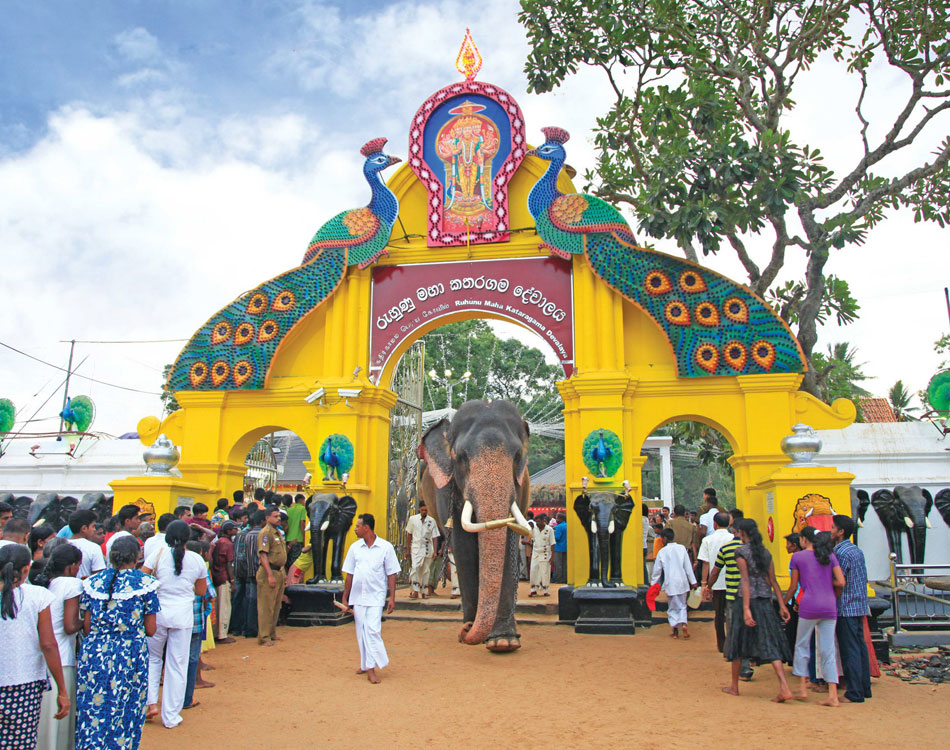KATARAGAMA TEMPLE
Kataragama temple is located in the multi-religious sacred city – Kataragama in Uva province, Sri Lanka. This temple complex is dedicated to God Kataragama usually is called Murugan or Kartikeya by Tamils & Kandasamy or God Skandha by Hindus. It is one of the few religious sites in Sri Lanka that is venerated by all the nationals - Buddhists, Hindus, Muslims and the Vedda people. For most of the past millennia, it was a jungle shrine very difficult to access; today it is accessible by an all-weather road. The shrines and the nearby Kiri Vehera are managed by Buddhists, the shrines dedicated to Teyvāṉai and Shiva are managed by Hindus and the mosque by Muslims.
Up until the 1940s a majority of the pilgrims were Tamil Hindus from Sri Lanka and South India who undertook an arduous padayatra or "pilgrimage on foot". Since then most pilgrims tend to be Sinhala Buddhists and the cult of Kataragama deviyo has become the most popular amongst the Sinhalese people.
According to Hindus and some Buddhist texts, the main shrine is dedicated to Kartikeya, known as Murugan, Kumara, Skanda, Saravanabhava, Visakha or Mahasena is the chief of warriors of celestial Gods in Tamil sources. A Tamil rendition of the Skanda Purana known as the Kandha Puranam written in the 14th century also expands on legends of Valli meeting Murugan. The Kandha Puranam plays a greater role for Sri Lankan Tamils than Tamils from India, who hardly know it.
In Sri Lanka the Sinhala Buddhists also worshiped Kartikeya as Kumara deviyo or Skanda-Kumara since at least the 4th century, if not earlier. At some point in the past Skanda-Kumara was identified with the deity in Kataragama shrine, also known as Kataragama deviyo and Kataragama deviyo became one of the guardian deities of Sri Lanka.
Rich in history, Kataragama Temple stands on ground that has been considered hallowed for around 2,500 years--said to have been consecrated by Gautama Buddha himself.
It is difficult to reconstruct the factual history of the place and the reason for its popularity amongst Sri Lankans and Indians based on legends and available archaeological and literary evidence alone, although the place seems to have a venerable history. The lack of clear historic records and resultant legends and myths fuel the conflict between Buddhists and Hindus as to the ownership and the mode of worship at Kataragama.
The priests of the temple are known as Kapuralas and are believed to be descended from Vedda people. Veddas, too, have a claim on the temple, a nearby mountain peak and locality through a number of legends.
The main festival known in Sinhalese as Esela Perehera. It is celebrated during the months of July and August. About 45 days before the festival begins, the priests go into the forest and find two forked branches of a sacred tree. The branches are then immersed in the local river and kept at the shrines dedicated to Kataragama deviyo and Vali. When the main festival begins, the Yantra representing the deity is retrieved from its storage location, paraded through a street on top of an elephant, and carried to the Valli shrine. After two hours it is returned. On the last day of the festival the Yantra is left overnight at the Valli shrine and brought back to the main shrine. The priests conduct the rituals in silence, covering their mouths with white cloth. Associated with the main festival is fire walking arranged by a master of the ritual. Hundreds of devotees participate in fire walking, yet others participate in ecstatic dance forms called Kavadi and body piercing. Many of the pilgrims exhibit signs of being possessed.
You will be able to offer a fruit plater for the shrine of God Kataragama at main Devala and get the blessings!
Day Tours
See more
See less
Round Tours
See more
See less
Things To Do
See more
See less

